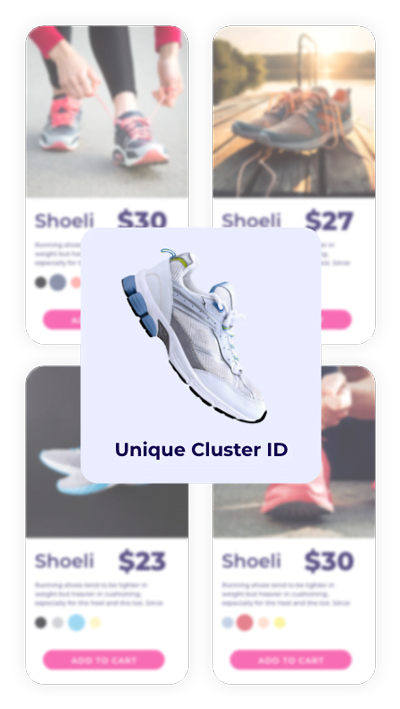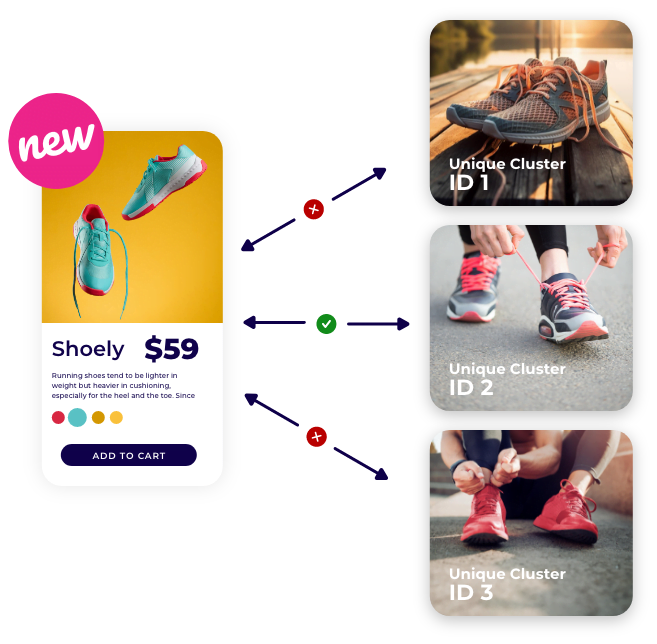With the introduction of Product Intelligence, we have taken a significant leap forward in the Ecommerce software industry and have opened countless possibilities for utilizing product data to enhance shopping experiences. In the process, we have encountered the challenge of processing and analyzing incredibly vast and constantly updating amounts of data. To overcome this new challenge, we developed Product Clusters. In a few words, Product Clusters are representations of groups of similar products that share a certain amount of common attributes. When running AI learning processes, instead of dealing with individual product data, we use these groups of product variations. This approach simplifies the process while also generating more stable datasets to work with.
How Product Clusters are used with AI
Our specialized AI system uses advanced grouping methods to find patterns and connections among a wide variety of retail products. This technology integrates diverse machine learning models, from natural language processing to image recognition.
For instance, we want to learn how customers engage with a type of sneakers. When we look in the database, we can see many variations of the same sneakers, such as variations of colours, prices, and models. Therefore we want to group all these products and give it a unique Cluster ID. The intelligence we gather from products with the same Cluster ID is used to identify patterns and predict shopping behaviour.
Now let’s say we want to create product recommendations for all the sneakers in this group. We don’t need to generate recommendations for each of them individually, as it will require a lot of resources. Instead we streamline the process by applying the same recommendation algorithm to all products within the same Cluster.
Read more about How our Product Intelligence Engine is used for our Product Recommendations.

How it works – transforming products into Vectors
Each product page contains information such as an image, title and description. As humans, we use this information to distinguish products and find similarities among them. But with the millions of products out there, this process would surpass human capacity. This is where Artificial Intelligence comes into the picture. It translates titles, descriptions, and images into numerical data, creating vectors. Our system reads the vectors and positions them in a hypothetical space, where it identifies vectors that are close enough to be part of the same cluster. Therefore, Product Clusters contain aggregated, anonymized data, that can’t be connected to any store.
Advantages of Product Clusters for the shopping industry
Product inventories undergo constant updates, including the introduction of new products, variations of existing models, and often the removal of items from the database. To prevent the loss of all historical data associated with deleted items, Clusters function as memory boxes, storing information even in the absence of some products. Of course, once all relevant items are removed from the database, the cluster will also disappear.
Another advantage is obtaining intelligence for newly added items, which customers haven’t yet bought or engaged with. But because they are similar to items already in the database, they are assigned a cluster ID. Therefore, shops can, for instance, create product recommendations for newly added products using the data from the Product Cluster. Entirely new products will create their own new clusters, where new data will be aggregated over time.


Product Clusters are a key element of our predictive system Product Intelligence, which translates product information into vectors of bits and bytes, a series of numbers, discovering dependencies and similarities. This information trains our AI models in product understanding and awareness, providing core value to any professional shop owner, whether traditional commerce with physical stores or full-blown Ecommerce businesses. Read more about it in our article Product Intelligence – A product-centric AI opportunity that dives deeper into the subject.
Explore more about Pi
Maximize Profits with the Knowledge of Product Discount Distribution
- Ecaterina Capatina
- product intelligence
Unlock Important Insights into Recurring Products
- Ecaterina Capatina
- product intelligence
Target customers at the right time of the day with Hourly Distribution
- Ecaterina Capatina
- product intelligence





